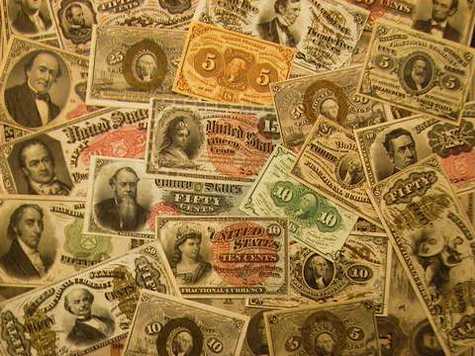
During the early years of the Civil War, in response to the political uncertainty of the time, the banking industry suspended the redemption of paper money for coin. The net effect of this action was to place a premium on coins vis-a-vis paper money and there resulted a widespread hoarding of coin by the public. Coins of all denominations were jealously guarded and hoarded and soon had all but disappeared from circulation. This was partly alleviated by small denomination (less than $1) U.S. postage stamps. People would encase the stamps and use them for trade.
The solution, generally credited to Francis
Spinner, Treasurer of the United States during the Lincoln
administration, was the issuance of a form of fractional notes
similar in appearance to the postage stamps they were designed to
replace in circulation.
In all there were five different issues, or major design types,
printed from 1862 until 1876, when production of these notes ceased.
The designs were changed with some frequency in response to an
alarming rate of counterfeiting.
This issue consisted of 5, 10, 25, and 50-Cent Notes and was called Postage Currency. These notes were issued illegally under the Act of Congress of July 17, 1862, because that Act only authorized payments in the form of postage stamps. The Act did not authorize the issuance of Postal Notes.


Stamps the notes were based from.
The obligation on these is "Exchangeable for United
States Notes by any Assistant Treasurer or designated U.S.
Depositary in sums not less than five dollars. Receivable in payment
of all dues to the U.States less than five Dollars"
This issue consisted of 5, 10, 25, and 50-Cent Notes, which were authorized by the Congressional Act of March 3, 1863, which also changed the name officially to "Fractional Currency." This Act also legalized the First Issue notes that had been used illegally. The Act also authorized the Treasury Department to print its own notes. The many counterfeits that appeared so quickly of the First Issue notes necessitated changes in the design, size and paper of the Second Issue notes.
The obligation on these is "Exchangeable for United States Notes by the Assistant Treasurers and designated depositaries of the U.S. in sums not less than three dollars. Receivable in payment of all dues to the United States less than five dollars except customs"
This issue consisted of 3, 5, 10, 25, and 50-Cent Notes. This issue came about through provisions of the Law of June 30, 1864, because of the serious problem of counterfeiting encountered with the second issue. S. M. Clark, Superintendent of the National Currency Bureau, suggested the second issue be withdrawn from circulation, and be replaced with a third issue. This was the first issue of Fractional Currency to contain signatures.
The obligation on these is similar to that on the Second Issue.
Head of Spencer M. Clark, First Superintendent of the National Currency Bureau (now the B.E.P.)
On the five cent note of this issue Congress had intended to honor Clark of the Lewis and Clark Expedition, but S. M. Clark, the Superintendent of the National Currency Bureau, put his own portrait on the note. This led to a Congressional uproar and the passing of a still existing rule forbidding the use of the image of a "living American" on the notes, coinage or obligations of the United States Government. The Law, however, did not prohibit the production of notes with living portraits on them, if the plates had already been prepared prior to the passage of that statute. Consequently, the notes with portraits of S. M. Clark, F. E. Spinner and William Pitt Fessenden were not illegally issued.
Heads of Union Generals William T Sherman and Ulysses S. Grant
(This note exists only as a Specimen)
Bust of William P. Fessenden, Secretary of the Treasury in 1864 under President Lincoln
Seated figure of Justice holding Scales
Head of General F.E. Spinner, Treasurer of the United States, 1861-1875
This issue consisted of 10, 15, 25, and 50 Cent Notes. This issue, just like the previous two issues, was initiated because of extensive counterfeiting. This issue also had many experiments with paper to find a deterrent to counterfeiting. Watermarks were tried and discontinued because of the short life of the note due to the weakened paper. A strip of blue fibers imbedded between two layers of paper was also tried.
The obligation on these is similar to that on the Second Issue.
Bust of Liberty
Bust of Columbia
Bust of Samuel Dexter, Secretary of both the War and Treasury Departments, 1800-1801
Bust of Edwin M. Stanton, Secretary of War under President Lincoln
This issue consisted of 10, 25, and 50-Cent Notes. The production of this issue exhausted the appropriations for printing Fractional Currency and no new funds were provided. The paper in this issue was all fiber, watermarked paper. The Treasury Seal appeared on all of the notes along with signatures.
The obligation on these is similar to that on the Second Issue.
Head of William M. Meredith, Secretary of the Treasury, 1849-1850.
Bust of Robert J. Walker, Secretary of the Treasury 1845-1849.
Bust of William H. Crawford, Secretary of both the War and Treasury Departments, 1815-1825